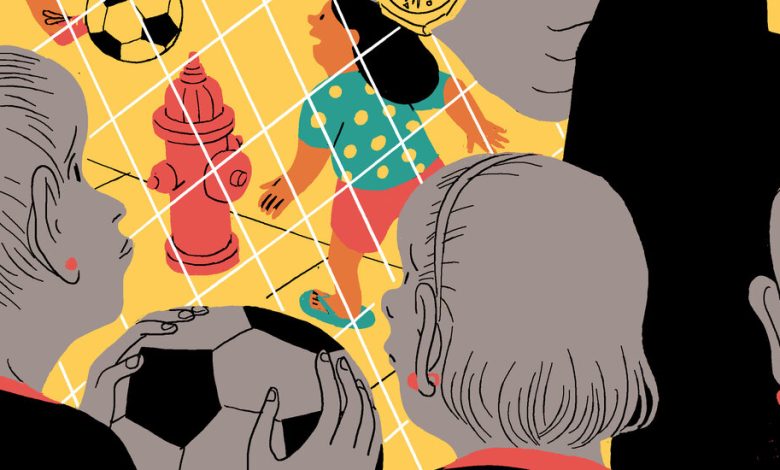Why Have We Allowed Money to Ruin Youth Sports?

My daughters love to swim, and we’d exhausted the lessons at our local Y, so I thought I’d try to find them a swim team. They’re only 6 and 9, so what I was looking for was a local rec situation that offered a bit of low-stakes camaraderie and regular exercise. They’re strong swimmers but probably not future Olympians, and besides, I want a life: I have zero interest in shuttling them up and down the Eastern Seaboard every weekend to compete, as the parents whose children are on travel teams seem to do.
The kind of chill athletic experience I wanted for my kids barely seems to exist anymore. There wasn’t anything like the delightfully bumbling soccer league of my youth. All I could find were intense teams that had practices several times a week. The only other regular swimming option for my children is lessons, which are expensive, and you need to sign up on the first day of registration or you’re out of luck.
I thought it might be just a New York City thing — often there are wait lists for all kinds of kid activities because there is so much demand and not enough supply. But it seems to be a cross-country problem: When I tweeted in frustration, lots of folks replied describing similar experiences — including a woman who wryly suggested that one might have to sacrifice a baby goat to get kids into swimming lessons in Portland, Ore.
This saddens me for so many reasons. A big one is that sports were such an important part of my tween and teen years. I wasn’t good enough to play in college, but I played soccer and field hockey through my senior year of high school. It always felt like a respite from adolescent drama, and it provided structure and solace on even the worst days. Being part of a team taught me a lot of lessons, not least of which that showing up on time and ready to play has tangible benefits, no matter what happens in the game.
But as Linda Flanagan explains in her new book, “Take Back the Game: How Money and Mania Are Ruining Kids’ Sports — and Why It Matters,” the problem is systemic. At its base, over the past several decades, “kids’ sports stopped being for kids.” There are fewer low-cost options, the time parents are spending on sports has ratcheted up and kids from lower-income families have less access to play. Instead, youth sports are about making adults money and fueling what some economists call the “rug rat race” — middle-class and upper-middle-class competition to get kids into colleges and secure their futures.
What follows is a condensed and edited version of a conversation I had with Flanagan, who is a journalist and runner who used to coach a high school girls cross-country team. She explains how we got to this place and what good can still be gained from youth sports.
Jessica Grose: I was excited to read your book because it explained something I have been noticing since my kids started wanting to play sports: the lack of low-stakes, local community options. I’d love to hear you explain where these options went.
Linda Flanagan: I identify three main reasons children’s sports has moved from this low-key, relaxed, around-the-corner kind of play to this intense, expensive, privatized version. The first is money.
The seeds of this were planted in the ’70s, when we had a bad recession and public funding for parks and recreation departments declined. Then girls sports really picked up in the ’90s, so there was more demand.
Also in the ’90s, Disney built the Wide World of Sports Complex, which proved to be wildly successful. It launched the beginning of travel sports and sports tourism because Disney’s success then was observed by other communities who thought: If they can build a sports complex, why don’t we try it in our little town? Those are the places that are pulling in teams and tournaments and competitions where those private entities have their games.
Then, in 2008, we had another recession, which led to a further decline in public spending and a realization among private enterprise that they can make money off this.
I was shocked at how much money is being made. The figure you cite in the book was an estimated $19.2 billion — which is more than the value of the N.F.L. And what really struck me was that there was a 90 percent increase in spending since 2010. I know you just mentioned the recession in 2008, which cut more funding from rec sports, but what else has exponentially accelerated that money spent?
I spoke to the woman who did the research on this, and she said that the increase is due to a lot of software and tech investments. There are now companies that provide software for leagues, and organizing and videography to send tape of your little superstar to college coaches. She said the next step in this sports tourism is upgrading the facilities so that parents, they’re not just going to some stadium in the middle of nowhere, but maybe they have a nice coffee bar and comfortable seating.
In the book, you argue that all the money in the system corrupts oft-cited benefits of sports, like character building. I’d love to hear you speak more about that.
As soon as you add money, it changes what’s at stake. I think one of the most important bits of research in the book is what came out of the Families in Sport Lab at Utah State. They discovered that the more parents spend on their kids’ sports, the less the kid enjoys it and the more pressure they feel. Because of this youth sports industry, there’s now this pressure on kids to specialize at a young age, or to pick one sport and play it for as long as possible.
There’s a consensus among sports doctors and psychologists that this is not healthy. It’s not developmentally in a child’s best interest, but because there’s this industry that’s selling that message, that’s what has become of childhood for a lot of kids, is playing one sport all the time. Then if you can’t cut it, or you hate it, or you don’t want to have them swim five days a week when they’re 6 years old, you just leave it. That’s how it has corrupted what’s wonderful.
I also think it’s because there is a lack of less intense options. It feels like you either play this game of starting your kid at lacrosse at 5 or they’ll never get to play at all. And that feels terrible, right?
Yes, exactly. It does. There’s another giant cause of all this that we didn’t talk about when we talk about money. One of the most interesting parts of my research for the book was trying to understand how the whole notion of parenthood changed so much. I’m the youngest of five, and I said, “Mom, how did you ever have five kids?” She said, “Oh, I don’t know, Linda. We just didn’t think about it so much back then.”
To understand how we moved from children “being our employees to our bosses,” as Jennifer Senior put it [in her book “All Joy and No Fun: The Paradox of Modern Parenthood”] — I love that turn of phrase because the power dynamic shifted. It used to be that parents were the ones who had the lives, and kids had to adapt to this shift, beginning in the ’70s, ’80s and ’90s, where kids became the center around which life revolved for the adults.
Now, parents think we have to do everything in our power to make sure that our children have every advantage, and to set them up for a happy and economically satisfying life. If we don’t do it, they will likely fail. As a result, it’s a sign of a good parent to spend $10,000 on travel lacrosse or travel soccer because you’re doing what you have to do to help prepare your kid. That’s the overlay in the back of all this, this mentality that it’s your responsibility as a parent to do this and you’re being a bad parent if you don’t. There’s that guilt that I think many parents feel if they opt out of some of this stuff.
What seems strange to me is not all children are going to be great athletes. You talk about your three kids in the book, and only one really seemed like he had that spark. I imagine a lot of kids are being pushed when they’re either not particularly interested or don’t have the skill level.
Yes. I know. Well, that’s the other reality. We can’t really shape them as much as we like to think we can.
We’ve talked about a lot of downsides, but when I want to give up on the treadmill, I still hear the voice of my high school field hockey coach, Barb, in my head, saying: “Finish strong.” I feel that I learned that kind of resilience more from playing sports than from anything else I did in my young life. What were some other positive takeaways you observed from youth sports?
Toward the end of my coaching career, I started sitting down with the team at the end of the season and asking: What did you learn here that you can apply to the rest of your life? Because in a perfect world, sports are not just about that particular season or game. You’re supposed to take something from it to grow. And their responses were so wonderful. One girl who always had trouble running said she learned the power of baby steps, because when we started she couldn’t run very far at all, and by the end she could do a 5K. Other girls said they learned that they were stronger than they thought they were. They learned: I can do this. I didn’t know I could, and I can.
Want More?
-
Last year in her newsletter, Anne Helen Petersen made the case against kids’ sports. She also interviewed Flanagan this month, and she’s more skeptical than me about whether kids’ sports can be saved.
-
The inequality of the lack of local community options for play has terrible consequences: As my colleague Mara Gay pointed out earlier this year, the City of New York canceled free swim lessons. Forget a swim team — lots of kids don’t get to learn how to swim, and don’t have access to the water on the hottest days.
-
In 2018, my colleague Jane Brody discussed how to avoid burnout in youth sports. “In a prospective study of nearly 12,000 youngsters with highly accurate histories of sports-related injuries,” she wrote, experts found that “early specialization in baseball, cheerleading and gymnastics increased the risk of injury among boys, and specialization in running, swimming, soccer and volleyball, as well as cheerleading and gymnastics, increased the injury risk among girls.”
-
Do Scandinavians have an answer, yet again, to an American parenting problem? Writing for The Times in 2019, Tom Farrey wondered: “Does Norway Have the Answer to Excess in Youth Sports?”
Tiny Victories
Parenting can be a grind. Let’s celebrate the tiny victories.
If you want a chance to get your Tiny Victory published, find us on Instagram @NYTparenting and use the hashtag #tinyvictories; email us; or enter your Tiny Victory at the bottom of this page. Include your full name and location. Tiny Victories may be edited for clarity and style. Your name, location and comments may be published, but your contact information will not. By submitting to us, you agree that you have read, understand and accept the Reader Submission Terms in relation to all of the content and other information you send to us.




